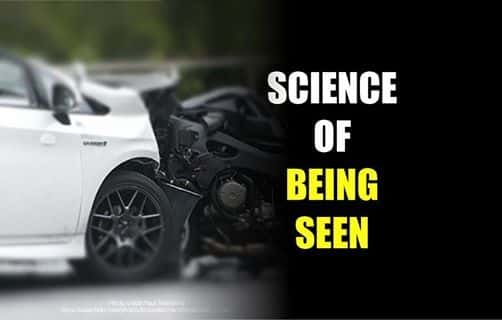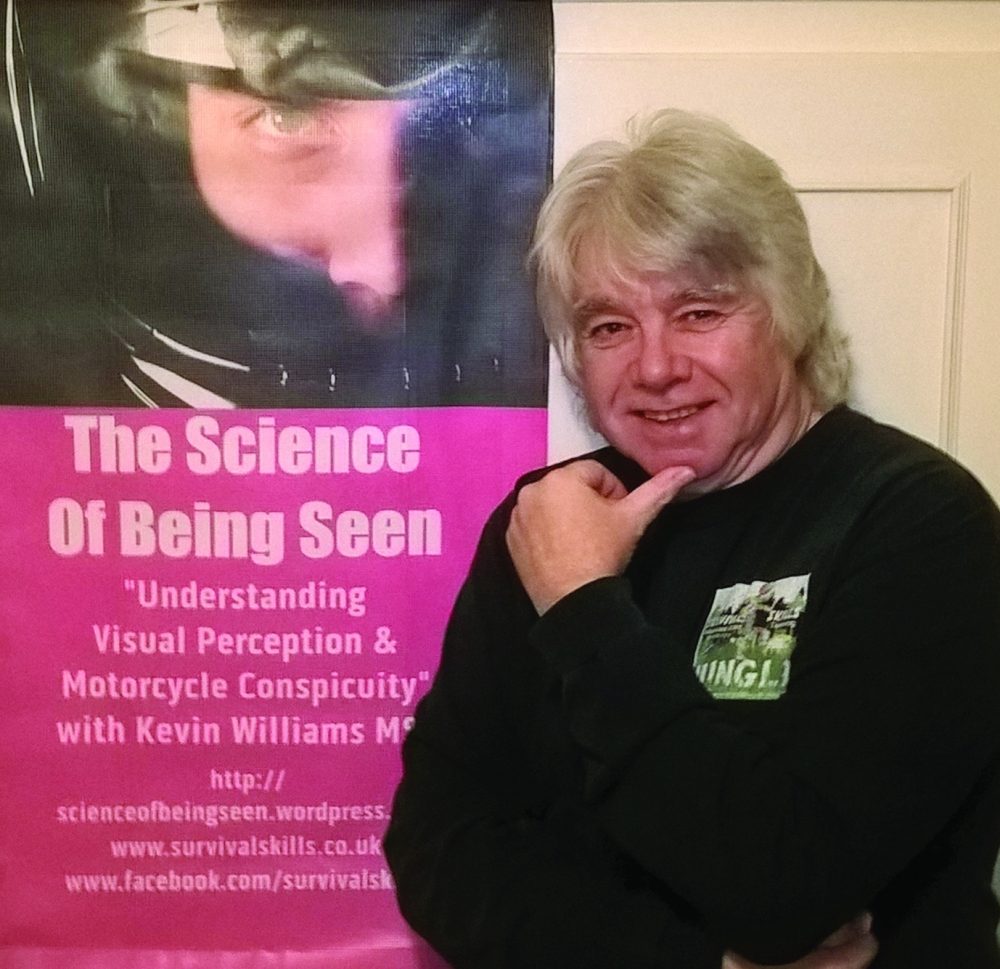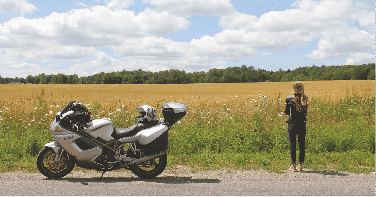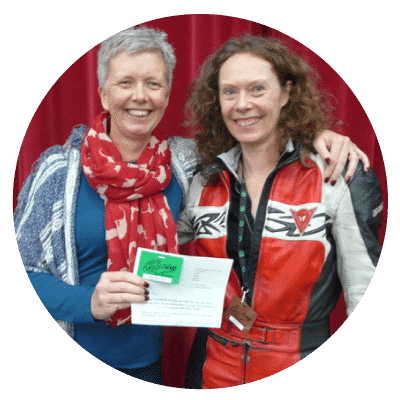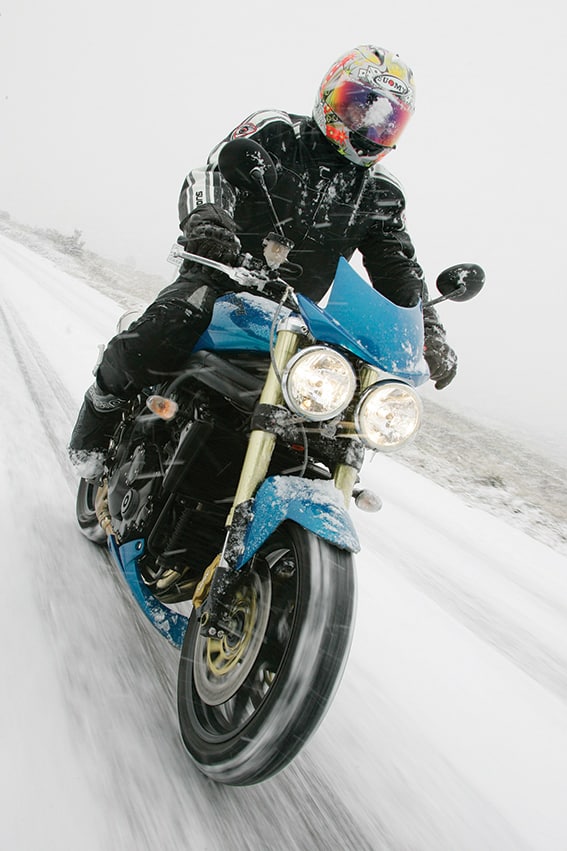‘RIDE BRIGHT’ or ‘THINK BIKE’ success?
I’ve made a start on what the Science Of Being Seen – both the research and the presentation – is all about, and I mentioned a bit about the background context and just why I felt it necessary to put this work together.
The answer is that although the ‘RIDE BRIGHT’ motorcycle conspicuity campaigns aimed at bikers and their logical counterpart, the ‘THINK BIKE’ campaigns that exhort drivers to look harder for the difficult-to-see two wheeler, have been running from the mid-70s to the current day, and although they have run all over the world, and either adopted voluntarily or enforced through legislation, there’s no significant evidence that either strategy has had any significant impact on collisions between bikes and cars.
Drivers still suffer the ‘Looked But Failed To See’ (LBFTS) error and commit the ‘Right Of Way Violation (ROWV). As you can see, they’ve been happening for so long and studied so intensively, the research has created a pair of acronyms.
And riders still sail into these crashes all too regularly. Riders have also known about this collision for so long they’ve given it their own their own nickname – the ‘Sorry Mate I Didn’t See You’ SMIDSY.
So let’s go back to the beginning of the story.
As long ago as 1975, the Greater London Road Safety Unit identified powered two-wheelers (PTWs) as being over-represented in accidents. Detailed analysis followed and the results indicated that a major contributory factor was that other drivers failed to see the motorcycles in the general street scene.
The Greater London ‘Ride Bright’ campaign followed. It’s likely it was the first road safety campaign specifically designed to encourage riders of powered two-wheelers to improve their conspicuity by wearing bright clothing, preferably of fluorescent material, and by switching on their headlights in daytime. The campaign was extensive, involving radio advertising, a poster campaign, leaflets distributed through a number of routes (including dealers, garages, colleges, businesses and by London’s Metropolitan Police Service) and give-away items such as combs, pens and key-rings.
At around the same time, a US researcher named Harry Hurt (of whom you may have heard) working with Dupont wrote in 1977 that:
“the most likely comment of an automobile driver involved in a traffic collision with a motorcycle is that he, or she, did not SEE the motorcycle…”.
Hurt became synonymous with research into motorcycle crashes a few years later when he put his name to a mammoth study that became known as the ‘Hurt Report’ (1981). It has become a seminal work and you can find it easily online. Based on his research in California, what Harry Hurt found (amongst other things) was that:
“Approximately 3/4 of motorcycle accidents involved collision with another vehicle at an intersection. The driver of the other vehicle violated the motorcycle right-of-way and caused the accident in 2/3 of those accidents and did not see the motorcycle or did not see the motorcycle until too late to avoid the collision. Most involved passenger cars…”
A few years later, on our own side of the Big Pond, Keith Booth looked at 10,000 motorcycle crashes in London. Although I cannot find the original research, he released a report called “Characteristics of Urban Motorcycle Accidents” through the Institute of Motorcycling. Booth’s observation was that in London:
“62% of motorcycle accidents were primarily caused by the other road user. In 2/3 of motorcycle accidents where the driver was at fault, the accident was due to the driver failing to anticipate the action of the motorcyclist.”
In other words, much the same crashes were happening in big cities on both sides of the Atlantic and in much the same proportions.
The obvious question was: “Why?” Hurt drew much the same conclusion as the earlier GLC study in London:
“The origin of this problem seems to be related to the element of conspicuity (or conspicuousness) of the motorcycle; in other words, how easy it is to see the motorcycle. When the motorcycle and the automobile are on collision paths, or when the vehicles are in opposing traffic, the conspicuity due to motion is very low, if it exists at all.”
I’ll be coming back to this concept of ‘motion conspicuity’.
Hurt continued, “Consequently, recognition of the motorcycle by the automobile driver will depend entirely upon the conspicuity due to contrast.
“If the approaching motorcycle and rider blend well with the background scene, and if the automobile driver has not developed improved visual search habits which include low-threat targets (such as motorcycles and bicycles, as contrasted with the high-threat targets presented by trucks and buses) the motorcycle will not be recognized as a vehicle and a traffic hazard exists.”
Note that phrase about depending ‘entirely on the conspicuity’ – it’s going to be important too.
These accidents are often categorised as ‘Looked But Failed To See’ errors (LBFTS), because the driver claims that they looked in the appropriate direction for conflicting traffic, but did not see the approaching motorcycle.
If drivers were colliding with motorcycles that they hadn’t seen because the motorcycle had poor conspicuity, what was the answer? Not surprisingly, the road safety bodies came up with two ‘common sense’ answers:
- motorcyclists should make themselves more conspicuous by wearing light-coloured, reflective and fluorescent hi-vis clothing and white helmets, and to ride with dipped headlights on, and if they did, this would help drivers see them
- drivers should look harder for motorcycles – drivers were told to ‘Think Bike’ and to look twice or take longer to look for them, and if they did this they would see bikes.
And that’s pretty much where we are now.
So… did any of this work?
Clarke et al (2007) investigated a sample of crashes involving motorcycles in the UK:
“A sample of 1790 accident cases was considered, including 1003 in detail, from UK midland police forces, involving motorcyclists of all ages, and covering the years 1997-2002 inclusive. Significant differences were discovered in the sample with respect to types of accidents involving motorcyclists (and their blameworthiness). There seems to be a particular problem surrounding other road users’ perception of motorcycles, particularly at junctions. Such accidents often seem to involve older drivers with relatively high levels of driving experience who nonetheless seem to have problems detecting approaching motorcycles.”
Even more recently, Helman et al (2012) wrote in a paper for the Transport Research Laboratory (TRL) that:
“It is widely accepted that one key factor in motorcyclist crashes around the world is the difficulty other road users have in detecting an approaching motorcyclist or correctly appraising their speed and position. This is of particular concern at road intersections, when drivers need to detect gaps in oncoming traffic to make turns either across or into traffic flows. If a motorcyclist is not detected by a car driver in this situation (so-called ‘looked but failed to see’) then this can lead to a manoeuvre that violates the motorcyclist’s path, and a potential crash.”
If we look outside the UK but still within Europe, the pan-European study ‘Motorcycle Accidents In-Depth Study’ (or MAIDS for short), first released in 2004 then updated in 2009, found that just over half of all crashes involving a powered two-wheeler (ie a motorcycle or moped) took place at an intersection. 60% of these collisions were with a car, 72% of the accidents took place in urban areas, and in 50% the car driver was to blame. And the important conclusion was that in over 70% of the collisions resulting from an error on the part of the other driver, the collision involved a failure to see the a motorcycle.
And the latest study from Transport for London on motorcycle crashes in the capital repeated the findings that the car – motorcycle collision at a junction remains the biggest single issue facing riders.
So, the conclusion is inescapable. The interventions first recommended in the 1970s and early 80s don’t seem to have had any effect on the prevalence of the LBFTS error. And so the SMIDSY remains the most common crash involving a bike and another vehicle.
If our generation of riders is to do any better, we need to look for a better explanation. And we need to do it ourselves, not rely on what we’re told. And that’s why I’ve spent so much effort working on SOBS over the last nine years.
Kevin Williams / Survival Skills Rider Training www.survivalskills.co.uk
(c) K Williams 2020
The Science Of Being Seen – the book of the presentation £9.99 plus P&P and available now from: www.lulu.com
The ‘Science Of Being Seen’ is a presentation created in 2011 for Kent Fire and Rescue’s ‘Biker Down’ course by Kevin Williams. Biker Down is now offered by over half the nation’s FRSs as well as the UK military, and many deliver a version of SOBS. Kevin personally presents SOBS once a month for KFRS in Rochester. He toured New Zealand in February 2018 delivering SOBS on the nationwide Shiny Side Up Tour 2018 on behalf of the New Zealand Department of Transport.
Find out more here: https://scienceofbeingseen/wordpress.com

